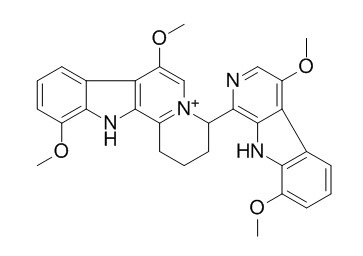Picrasidine S
Picrasidine S shows the potent cytotoxicity against human HeLa cervical, gastric MKN-28, and mouse melanoma B-16 cancer cells, it also shows the potent antibacterial activity against two strains of pathogenic bacteria methicillin-resistant Staphylococcus aureus (MRSA) and two strains of pathogenic bacteria methicillin-sensitive Staphylococcus aureus (MSSA).
Inquire / Order:
manager@chemfaces.com
Technical Inquiries:
service@chemfaces.com
Tel:
+86-27-84237783
Fax:
+86-27-84254680
Address:
1 Building, No. 83, CheCheng Rd., Wuhan Economic and Technological Development Zone, Wuhan, Hubei 430056, PRC
Providing storage is as stated on the product vial and the vial is kept tightly sealed, the product can be stored for up to
24 months(2-8C).
Wherever possible, you should prepare and use solutions on the same day. However, if you need to make up stock solutions in advance, we recommend that you store the solution as aliquots in tightly sealed vials at -20C. Generally, these will be useable for up to two weeks. Before use, and prior to opening the vial we recommend that you allow your product to equilibrate to room temperature for at least 1 hour.
Need more advice on solubility, usage and handling? Please email to: service@chemfaces.com
The packaging of the product may have turned upside down during transportation, resulting in the natural compounds adhering to the neck or cap of the vial. take the vial out of its packaging and gently shake to let the compounds fall to the bottom of the vial. for liquid products, centrifuge at 200-500 RPM to gather the liquid at the bottom of the vial. try to avoid loss or contamination during handling.
Biol Pharm Bull.2017, 40(6):797-806
Biomed Pharmacother.2021, 144:112300.
J Ethnopharmacol.2024, 318:116863.
Heliyon.2023, 9(6):e16138.
J Food Biochem.2021, 45(7):e13774.
Molecules.2019, 24(16):E2985
Pharmaceuticals (Basel).2021, 14(10):1046.
Plants (Basel).2021, 10(2):278.
J Agric Food Chem.2021, 69(14):4210-4222.
Phytomedicine.2021, 83:153483.
Related and Featured Products
Chinese Traditional\s&\sherbal Drugs, 2015,46 (6) :803-7.
Three bis-β-carboline alkaloids from Picrasma quassioides and their bioactivities[Reference:
WebLink]
To study the chemical constituents from the stems of Picrasma quassioides.
METHODS AND RESULTS:
The constituents were isolated and purified by silica gel, Sephadex LH-20, ODS column chromatographies, and preparative HPLC. Their structures were determined on the basis of their physicochemical properties and spectral data. The cytotoxic and antibacterial activities were assessed by MTT and MIC, respectively. Three β-carboline alkaloids were obtained from the 95% ethanol extract of the stems of P. quassioides and identified as picrasidine F (1), picrasidine G (2), and Picrasidine S (3). Compound 1 showed selective cytotoxicity to HeLa cell, while compounds 2 and 3 showed the potent cytotoxicity against human HeLa cervical, gastric MKN-28, and mouse melanoma B-16 cancer cells. Compounds 1-3 showed the potent antibacterial activity against two strains of pathogenic bacteria methicillin-resistant Staphylococcus aureus (MRSA) and two strains of pathogenic bacteria methicillin-sensitive Staphylococcus aureus (MSSA).
CONCLUSIONS:
The assignments of NMR data of compound 1 are reported in this paper for the first time. Compounds 1-3 show the potent cytotoxic and antibacterial activities.



